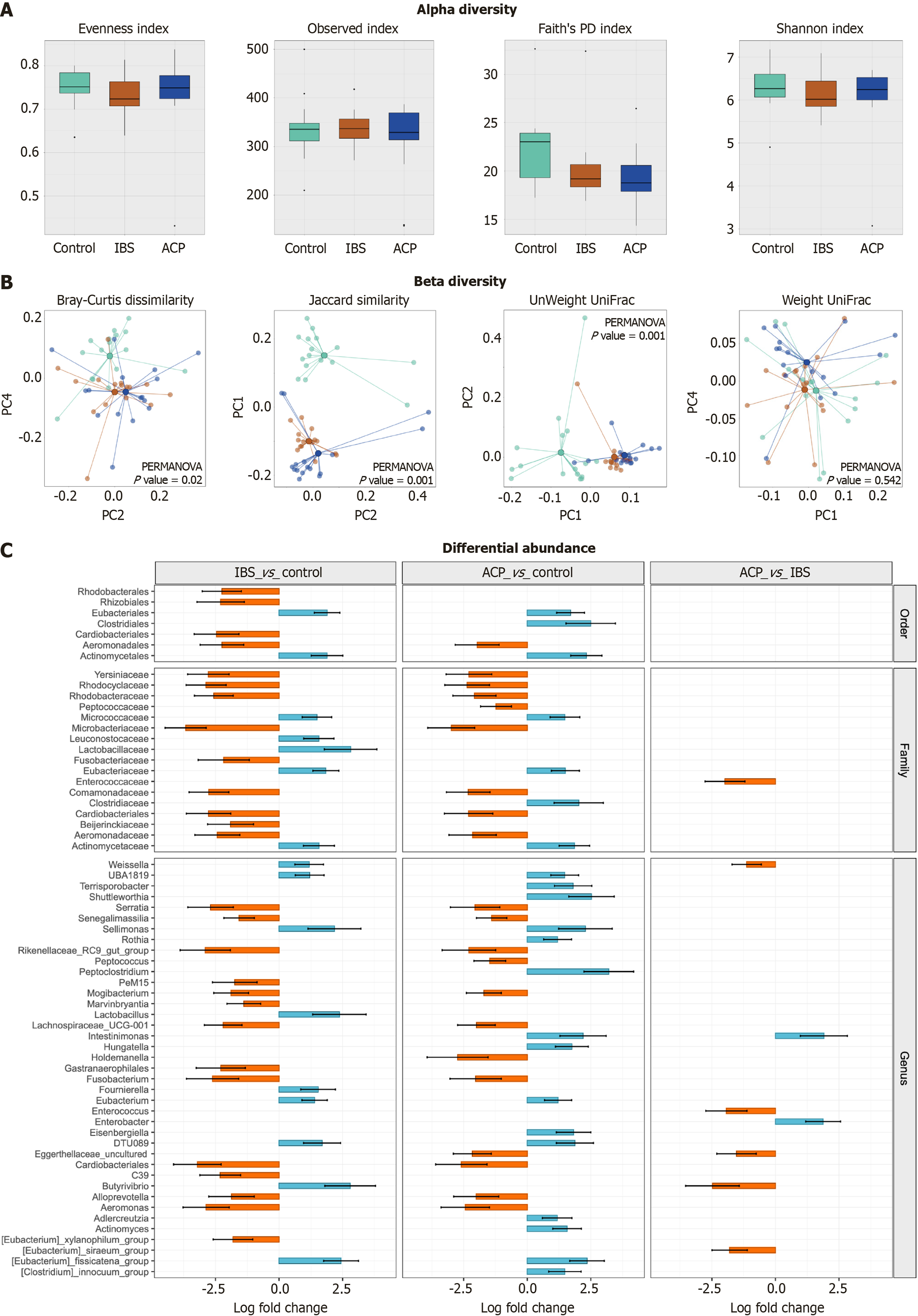Copyright
©The Author(s) 2025.
World J Gastrointest Pharmacol Ther. Sep 5, 2025; 16(3): 109046
Published online Sep 5, 2025. doi: 10.4292/wjgpt.v16.i3.109046
Published online Sep 5, 2025. doi: 10.4292/wjgpt.v16.i3.109046
Figure 1 Diversity of gut microbiota and their composition in healthy controls, patients with irritable bowel syndrome with predominant constipation at baseline and after electroacupuncture.
A: Alpha diversity is presented as boxplots; B: Beta diversities were presented by the principal coordinate analysis plot; C: Differential abundance calculated by Analysis of the Composition of Microbiomes with Bias Correction are presented as bar plots of beta coefficients and standard error of beta. Orange and blue colors represent decrease and increase of gut microbiota respectively, with the corresponding columns. Only taxa with significant associations after being adjusted with the Bonferroni correction are presented. IBS: Irritable bowel syndrome patients; ACP: Irritable bowel syndrome patients after electroacupuncture; PERMANOVA: Permutational multivariate analysis of variance.
Figure 2 Diversity of gut microbiota and their composition in healthy controls, patients with irritable bowel syndrome with predominant constipation at baseline, after electroacupuncture and one-month follow-up.
A: Alpha diversity is presented as boxplots; B: Beta diversities were presented by the principal coordinate analysis plot; C: Differential abundance calculated by Analysis of the Composition of Microbiomes with Bias Correction are presented as bar plots of beta coefficients and standard error of beta. Orange and blue colors represent positive and negative associations respectively, with the corresponding columns; D: Correlation between microbial genera change in irritable bowel syndrome (IBS) symptom including IBS-SSS and IBS-QoL. Only taxa with significant associations after being adjusted with the Bonferroni correction are presented. ACP: Irritable bowel syndrome patients after electroacupuncture; ACP1M: Irritable bowel syndrome patients after electroacupuncture and one-month follow-up; IBS: Irritable bowel syndrome patients; IBS-SSS: Irritable bowel syndrome symptom severity scale scores; IBS-QoL: Irritable bowel syndrome quality of life; PERMANOVA: Permutational multivariate analysis of variance.
Figure 3 Predicted neurotransmitter-related metabolic pathways analyzed by Phylogenetic Investigation of Communities by Reconstruction of Unobserved States 2, compared between healthy controls and irritable bowel syndrome with predominant constipation responders to electroacupuncture, indicating potential microbiome shifts associated with therapeutic response.
ACP: Irritable bowel syndrome patients after electroacupuncture; ACP1M: Irritable bowel syndrome patients after electroacupuncture and one-month follow-up; IBS: Irritable bowel syndrome patients.
Figure 4 Gut composition in irritable bowel syndrome with predominant constipation responders to electroacupuncture and irritable bowel syndrome with predominant constipation non-responders to electroacupuncture.
A: Differential abundance calculated by Analysis of the Composition of Microbiomes with Bias Correction are presented as bar plots of beta coefficients and standard error of beta. Orange and blue colors represent positive and negative associations respectively, with the corresponding columns; B: Shared differentially abundant genera across responders and non-responder to electroacupuncture in patients with irritable bowel syndrome with predominant constipation by Venn diagram; C: Correlation between electroacupuncture-responsive bacterial and change in clinical scores. Only taxa with significant associations after being adjusted with the Bonferroni correction are presented. aP < 0.01. ACP: Irritable bowel syndrome patients after electroacupuncture; HAD: Hospital Anxiety and Depression Scale in the part of anxiety; IBS: Irritable bowel syndrome patients; IBSS: Irritable bowel syndrome symptom severity scale scores; IBSQ: Irritable bowel syndrome quality of life; MDA: Malondialdehyde.
- Citation: Yaklai K, Kunasol C, Suparan K, Apaijai N, Chitapanarux T, Pattanakuhar S, Chattipakorn N, Chattipakorn SC. Electroacupuncture alleviates symptoms and identifies a potential microbial biomarker in patients with constipation-predominant irritable bowel syndrome. World J Gastrointest Pharmacol Ther 2025; 16(3): 109046
- URL: https://www.wjgnet.com/2150-5349/full/v16/i3/109046.htm
- DOI: https://dx.doi.org/10.4292/wjgpt.v16.i3.109046
















